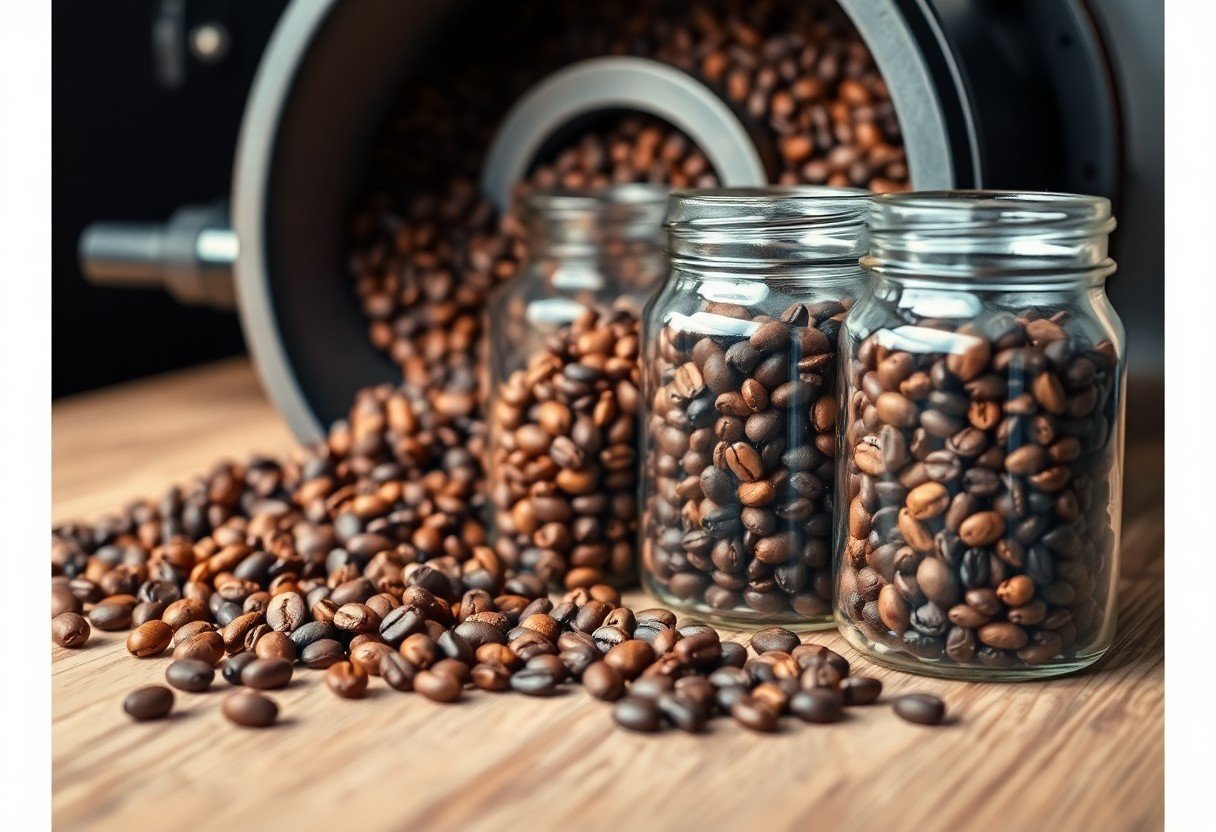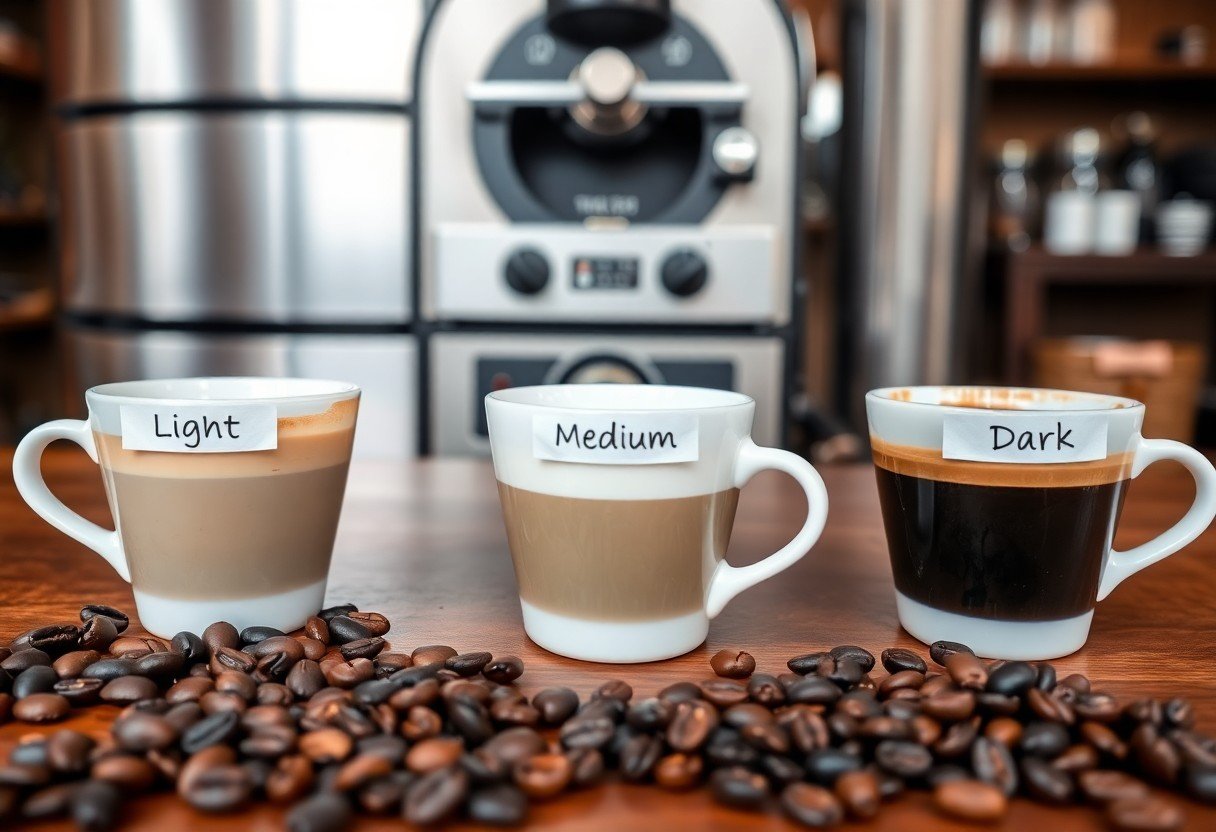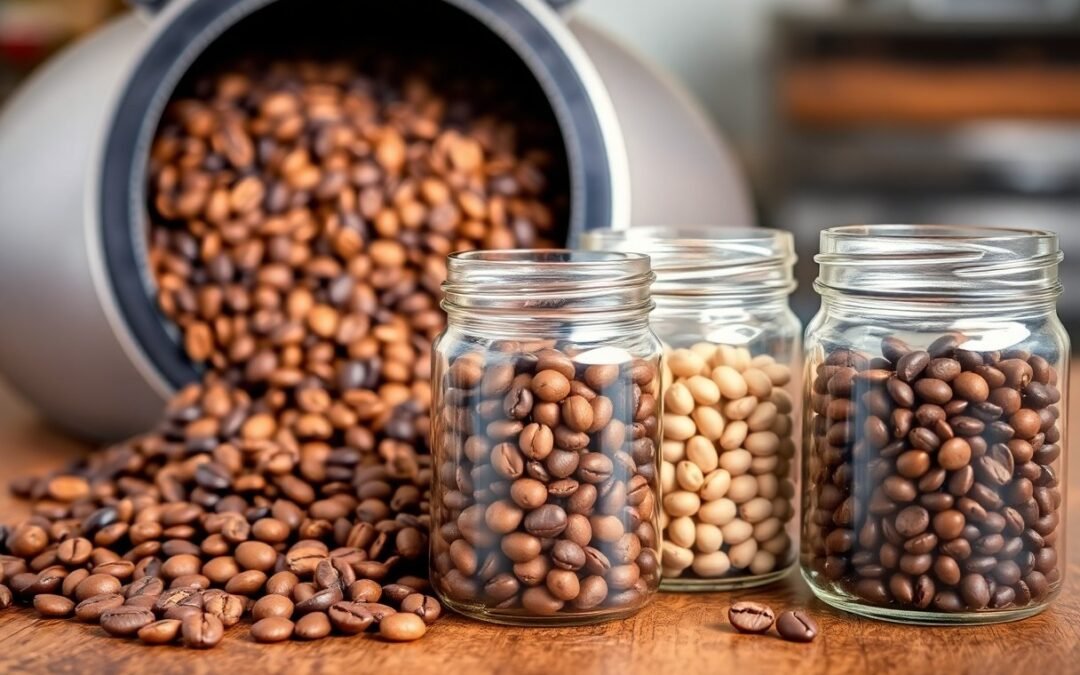Artisan coffee encompasses a range of flavors influenced significantly by roast levels. As you explore different roasts, you’ll notice how light, medium, and dark profiles affect acidity, sweetness, and body. Understanding these nuances allows you to appreciate how your coffee is crafted and helps you select the perfect cup to match your taste preferences. Dive into the science behind roasting and discover how these processes shape the vibrant profiles that define artisan coffee.
The Roast Spectrum: More Than Just a Color
Artisan coffee’s complexity unfolds through the roast spectrum, which extends beyond mere visual cues. While many focus on the color of roasted beans, understanding the subtleties and effects of each roast level can significantly enhance your coffee experience. Different roast levels exhibit unique characteristics and flavor profiles that can transform your morning cup into a sensory delight.
Examining the Roast Levels
You’ll find roast levels categorized mainly as light, medium, and dark, each impacting flavor and aroma. Light roasts tend to preserve most of the bean’s original characteristics, highlighting floral and fruity notes. Medium roasts strike a balance, introducing sweetness while maintaining some brightness. Dark roasts bring forward bold, smoky flavors, often at the expense of the bean’s inherent qualities.
How Roast Color Relates to Flavor Nuances
Roast color plays a vital role in determining the flavor nuances you will experience in your coffee. Lightly roasted beans display bright acidity and clarity, showcasing the region’s specifics. As the roast deepens, acidity typically diminishes, and roasted notes begin to emerge, creating a richer, fuller body. Dark roasts often have a bittersweet profile, masking original flavors with intense caramelization that produces chocolate and nutty undertones.
In practice, light roast coffees, such as a subtle Ethiopian Yirgacheffe, can showcase delicate floral aromatics and citrusy brightness, whereas a dark Italian roast might overshadow these subtleties, presenting deep bittersweet chocolate and earthy tones. Understanding these color and flavor shifts allows you to curate your coffee selection based on desired taste, elevating your artisan experience significantly.

Flavor Chemistry: The Transformative Role of Heat
Understanding the chemical transformations occurring during roasting reveals how heat influences flavor development in your coffee. As beans are subjected to increasing temperatures, complex reactions such as Maillard Reaction and caramelization break down sugars and proteins, generating a range of compounds that contribute to the final taste. This metamorphosis, from bright and fruity to deep and caramelized, hinges on precise temperature control and timing, allowing you to unlock your desired flavor profile in each cup.
Chemical Changes During Roasting
As roasting progresses, your coffee experiences intricate reactions that redefine its composition. The moisture content evaporates, sugars caramelize, and acids develop, transforming raw green beans into aromatic pleasures. For instance, at around 320°F, the Maillard Reaction begins, producing melanoidins that add richness and complexity to the flavor. These changes vary with each roast level, dictating whether you taste vibrant citrus notes or deep chocolate undertones.
The Balance of Acidity, Sweetness, and Bitterness
Finding harmony among acidity, sweetness, and bitterness is fundamental to crafting a well-rounded coffee. Lighter roasts exhibit higher acidity, offering vibrant flavors, while medium roasts often strike a balance, revealing both the sweetness of caramelized sugars and nuanced bitterness. Dark roasts prioritize body and bitterness, often subduing subtle fruity notes. Each cup reflects your roast choice, guiding your overall tasting experience.
The balance among acidity, sweetness, and bitterness can dramatically shift the perception of flavors in your cup. Lighter roasts, with their inherent brightness, can bring out floral and fruit notes, appealing to those who enjoy a lively experience. A well-executed medium roast often provides a bridge, presenting nuanced flavors that combine sweetness and mild bitterness, pleasing a wide range of palates. In contrast, a darker roast may deliver a rich, bold profile where bitterness dominates, masking delicate flavors. Your preference for this balance will ultimately guide your roast selection, shaping your overall coffee journey.
The Art of Selection: Choosing Beans for Desired Profiles
Selecting the right beans is imperative for achieving your desired flavor profile in artisan coffee. Sourcing high-quality beans that align with specific taste characteristics allows you to craft a brew that reflects your personal preferences. Factors such as origin, varietal, and processing methods should guide your selection process, enabling you to hone in on the nuanced flavors you wish to emphasize in the final cup.
Origin and Variety Impact on Roast Results
The geographical origin and specific variety of coffee beans significantly impact how they respond to roasting. For instance, Ethiopian beans often exhibit floral and fruity notes, while Colombian beans are known for their balanced acidity and nutty undertones. Understanding these characteristics helps you select beans that will yield the desired flavor profile after roasting.
The Role of Processing Methods in Flavor Development
Processing methods profoundly influence the flavor and aroma of coffee. Techniques such as washed, natural, and honey processing alter the bean’s sugar levels and acidity, impacting the final cup’s complexity. Each method brings out distinct profiles; for instance, washed coffees tend to be cleaner with higher acidity, while natural processed beans provide richer, fruit-forward flavors.
Exploring the varying processing methods further reveals how these practices shape flavor nuances. Washed coffees, processed by removing the cherry’s outer fruit before fermentation, often deliver a more crisp and vibrant cup. In contrast, natural processed beans—with the fruit left intact during drying—yield deeper sweetness and pronounced berry notes. By understanding these distinctions, you can select beans that better align with your intended flavor outcomes, enhancing your artisan coffee experience.

Expert Insights: Roasters Share Their Perspectives
Interviews with Artisan Roasters
Artisan roasters bring unique insights into how roast levels shape coffee flavor profiles. In interviews, they emphasize that lighter roasts preserve the distinct characteristics of the bean, while darker roasts can enhance sweetness and body. They often recount specific experiences with sourcing beans from single-origin locations, showcasing how regional nuances are amplified through careful roasting techniques.
Analyzing Different Roasting Philosophies and Techniques
Roasters adopt varied philosophies that greatly impact flavor outcomes. Some prefer a light roast to highlight floral and fruity notes, aligning with the coffee’s natural complexity. Conversely, others gravitate towards a medium roast, balancing acidity and sweetness for a rounded taste. Techniques may involve variable temperatures or roasting times, aiming to control the Maillard reaction for desired flavor development.
For instance, using a lower temperature for an extended period can accentuate the origin’s unique traits, while a quick, high-temperature roast might create a bold, smoky profile favored in certain markets. By experimenting with these methods, roasters can cultivate signature styles, catering to diverse consumer preferences and enhancing the overall coffee experience. Each choice, from temperature to duration, plays a pivotal role in defining the final product’s flavor profile.
Sipping Experience: How Roast Depth Affects Tasting Notes
Roast depth significantly shapes your sipping experience, creating a spectrum of flavor nuances. Lighter roasts often showcase vibrant acidity and distinct fruit notes, while medium roasts balance sweetness with mild bitterness. Darker roasts, in contrast, deliver bold flavors where chocolate, caramel, and smoky undertones dominate. Each roast level invites a different emotional response, affecting how you perceive and appreciate the coffee’s complexity.
Identifying Flavor Notes Across Different Roast Levels
Flavor notes across roast levels reveal a fascinating journey through coffee’s profile. Lighter roasts emphasize origin characteristics, often highlighting floral and fruity notes. As the roast deepens, sweetness emerges alongside chocolate and nutty nuances. Darker roasts can strip away some of the origin flavors, enhancing bitterness and introducing earthy or smoky profiles. The key lies in exploring these variations through your own palate.
Case Studies of Popular Artisan Coffees and Their Flavor Profiles
Examining popular artisan coffees provides insight into how roast levels influence flavor. Each coffee’s origin and preparation methods contribute to their unique tasting notes. By analyzing case studies, you can identify patterns in flavor profiles tied to specific roast depths, enhancing your appreciation of the craft that goes into artisan roasting.
- Colombian Coffee: Light roast; notes of citrus and honey (Acidity score: 7/10).
- Ethiopian Yirgacheffe: Medium roast; balanced berry and floral notes (Sweetness score: 8/10).
- Sumatra Mandheling: Dark roast; earthy and chocolate flavors (Bitterness score: 6/10).
- Brazilian Santos: Medium roast; nutty with mild chocolate undertones (Body score: 8/10).
- Guatemalan Antigua: Light roast; bright acidity with notes of caramel and cocoa (Balance score: 9/10).
These case studies underscore the rich tapestry of flavors available in artisan coffees based on their roast levels. Through specific examples, you can see how characteristics like acidity, sweetness, and bitterness shift, drawing on the unique attributes of each coffee’s origin. This knowledge enables you to select the ideal roast for your preferred flavor profile.
- Colombian Coffee: 80% citrus, 20% honey; low bitterness, high acidity.
- Ethiopian Yirgacheffe: 70% berry, 30% floral; moderate sweetness with a hint of bitterness.
- Sumatra Mandheling: 60% earthy, 40% chocolate; low acidity, high body.
- Brazilian Santos: 50% nutty, 50% chocolate; low acidity, balanced body.
- Guatemalan Antigua: 50% caramel, 50% cocoa; bright acidity, excellent balance.
Summing up
To wrap up, understanding how roast levels influence artisan coffee flavor profiles allows you to enhance your coffee experience. Light roasts can highlight the inherent acidity and origin characteristics, while medium roasts provide balance with sweetness and complexity. Dark roasts often deliver bold flavors and aromas, but may obscure some nuanced notes. By experimenting with different roast levels, you can discover the flavors that best suit your palate and deepen your appreciation of this intricate beverage.
FAQ
Q: How do light roast levels affect coffee flavor profiles?
A: Light roast levels typically highlight the coffee’s inherent acidity and fruity notes. This roast level preserves more of the bean’s original flavors, often resulting in a bright, vibrant cup with floral or citrus qualities.
Q: What flavor characteristics are associated with medium roast levels?
A: Medium roast levels create a balance between acidity and body. The flavors become more rounded, with caramel and chocolate notes emerging. This roast level is popular for its versatility and richer taste while maintaining some of the original characteristics of the beans.
Q: How does a dark roast alter the flavor profile of artisan coffee?
A: Dark roast levels tend to produce a bolder, richer flavor with pronounced bitterness. The roasting process often results in smoky or chocolatey notes, diminishing the coffee’s original acidity and fruitiness. This style is favored for its strong, robust taste.
Q: What impact does roast level have on caffeine content?
A: Contrary to popular belief, lighter roasts actually contain slightly more caffeine than darker roasts. The roasting process reduces caffeine content, as the longer the beans are roasted, the more caffeine is lost in the process.
Q: How can roast level affect the brewing method choices?
A: The chosen roast level can influence the brewing method used for optimal flavor extraction. Light roasts often benefit from methods like pour-over that allow for controlled extraction, while dark roasts may be suited to espresso or French press methods that enhance their boldness.

